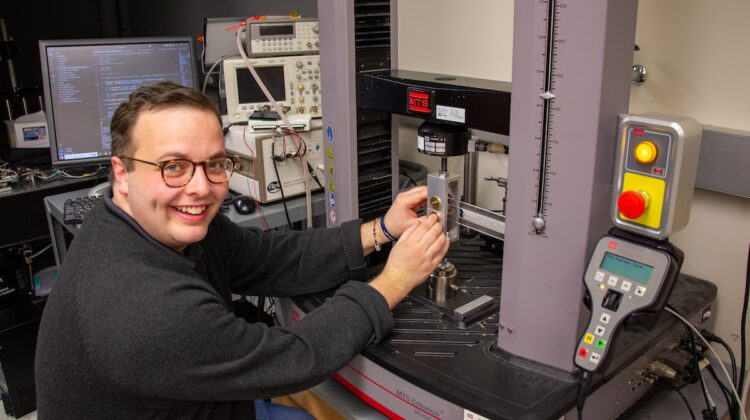
Researchers from the University of Pennsylvania and Aarhus University have demonstrated that adding just the right amount of disorder to the structure of certain materials can make them more than twice as resistant to cracking. According to the researchers, the finding opens the door to more widespread use of so-called ‘mechanical metamaterials’, a class of materials whose internal structures – often produced via digital manufacturing techniques such as 3D printing and laser cutting – give them unique properties, including enhanced strength or stiffness per weight.
One of the greatest challenges posed by mechanical metamaterials has been their fragility. ‘Toughness is a limiting factor in not all, but many 3D-printed mechanical metamaterials,’ said Kevin Turner, professor and John Henry Towne department chair of mechanical engineering and applied mechanics (MEAM) at Penn Engineering.
This new result promises to address this issue and at relatively low cost. ‘Without changing the material at all, just simply by altering the internal geometry,’ said Turner, ‘you can increase the toughness by 2.6 times.’
Natural materials commonly exhibit disorder at small scales. As examples, the researchers point to human bone, nacre, the iridescent material inside seashells, and the threads mussels use for attaching to surfaces. Rather than regular repeating structures, these materials contain minute, seemingly random variations in the space between their structural components.
For decades, engineers have taken inspiration from nature, typically by replicating easy-to-manufacture structures such as a honeycomb pattern, which reduces a material’s weight while maintaining its strength. Honeycomb structures can be found in some cardboard packaging and the metal reinforcements inside airplane wings. ‘That’s a very regular pattern,’ said Turner.
In contrast, the metamaterials tested by the reserachers exhibited a wide range of patterns, from regular to highly disordered. ‘The samples that performed the best, in which it was most difficult for a crack to grow, did not consist of regular repeating patterns,’ said Sage Fulco, a postdoctoral researcher in MEAM (pictured above). ‘They had a different geometry in different areas.’
To test whether disorder makes mechanical metamaterials tougher, the researchers performed thousands of computational-mechanics simulations of numerous different patterns, all based on a triangular lattice called a truss. In some, the triangles were arranged in perfect symmetry, while in others, the pattern had been perturbed by moving the nodes where the triangles meet.
The team subjected the patterns to rounds of computer simulations and created physical versions of a representative set of geometries, including both ordered geometries and those with varying levels of disorder.
When they attempted to break the materials – in the lab and in the simulations – a clear trend emerged. ‘There was a specific level of disorder, so that the patterns we cut into the material looked somewhat regular but not exactly symmetrical, where we were able to achieve the highest level of performance,’ said Fulco.
The perfect level of disorder – not too little, or too much – retained most of the material’s strength and stiffness while enhancing its toughness, but took substantially more effort to design than a repeating structure. ‘Disordered systems aren’t often used in engineering because the design is much more complex,’ Turner said.
Fulco worked with Michal Budzik, associate professor in mechanical and production engineering at Aarhus University, to fine-tune the fabrication process, traveling to Denmark to use an extremely precise laser cutter in Budzik’s lab to carve the patterns. ‘I had to completely rebuild our experimental setup to make use of their fabrication equipment,’ said Fulco. ‘But that allowed the experiments to actually succeed.’
To understand how the disordered structures increased toughness, the team ran an experiment conceived in collaboration with Douglas Durian, Mary Amanda Wood professor in physics and astronomy at Penn Arts & Sciences, and Hongyi Xiao, then a postdoctoral fellow in Durian’s lab.
When certain materials – including the polymer into which Fulco cut the patterns – are stretched, their birefringence, a property that causes light to split into two different paths, changes. Viewed through the right setup, the material’s appearance shifts with different levels of mechanical stress.
By taking images of samples with different patterns – some with a regular pattern and others with varying levels of disorder – while loading them to failure, the researchers were able to visualise exactly what happened as cracks propagated through the materials.
In short, the disorder prevented cracks from travelling in straight lines. ‘For the crack to grow through a disordered material, damage has to occur over a much larger area,’ said Fulco. In images captured by the team, fracture events appear closer together in a straight line in the symmetrical sample, but are scattered about in the optimally disordered one.
Moving forward, the researchers hope their findings will encourage a broader exploration of disordered patterns in mechanical metamaterials and mechanical design. ‘We used triangles, but this work is very fundamental,’ said Fulco. ‘Other groups can apply it to many different geometries.’
The success of the nature-inspired design also suggests that engineers may have significantly more to learn from the design of natural materials. ‘Combining different types of materials and adding different geometries at different scales are very exciting opportunities,’ said Fulco. ‘That’s what we see when we look at the highest performing natural materials.’
Ultimately, the team envisions these advances leading to the development of improved materials and structures with applications in industries such as aerospace, where resisting crack growth and tolerating damage are critical. ‘We’re enabling broader use of mechanical metamaterials in structural applications by identifying a geometric route to increase toughness,’ said Turner.
The research has been published in the Proceedings of the National Academy of Sciences Nexus.


